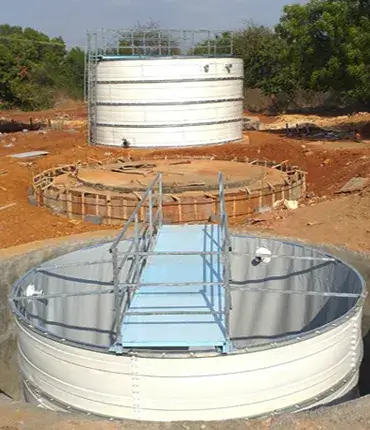Effluent Treatment Plant Tanks (ETP Tanks) Manufacturer
We are Manufacturer, Supplier, Designer of Effluent Treatment Plant Tanks, ETP Tanks, Effluent Water Storage Tanks in Wai, Satara,Pune, Maharashtra, India, We also Provide Fabrication / Installation / Maintenance Services.
Effluent Treatment Plant Tanks: (ETP Tanks) Manufacturer, Supplier
"ETP TANKS" typically refers to tanks used in Effluent Treatment Plants (ETP). These tanks are essential components in the treatment of industrial wastewater, ensuring pollutants are removed before the water is discharged into the environment or reused.
Benefits of ETP Tanks
ETP systems consist of several types of tanks, each serving a different purpose:
- Equalization Tank -Balances pH and flow; ensures consistent effluent loading.
- Neutralization Tank - Adjusts the pH of acidic or alkaline waste.
- Coagulation/Flocculation Tank - Adds chemicals to bind suspended particles.
- Primary Clarifier Tank - Settles heavy solids at the bottom.
- Aeration Tank - Introduces oxygen to promote microbial breakdown of waste.
- Secondary Clarifier - Settles biomass and sludge after biological treatment.
- Sludge Holding Tank - Stores sludge before dewatering or disposal.
- Treated Water Tank - Stores the final clean water for discharge or reuse.
Application Of ETP Tanks
ETP Tanks (Effluent Treatment Plant Tanks) are used for treating industrial wastewater so that it can be safely discharged into the environment or reused. These tanks are critical components of ETP systems and are widely used across various industries that generate liquid waste.
- Textile Industry
- Chemical & Pharmaceutical Industry
- Food & Beverage Industry
- Pulp & Paper Industry
- Leather Industry
- Oil & Petrochemical Industry
- Dye & Paint Manufacturing
- Metal Finishing & Electroplating
- Automotive Industry
- Hospitals and Laboratories
- Power Plants
Why Choose Us?
Why Choose Us ETP Tanks
- Industry-Specific Expertise - We design ETP tanks with deep knowledge of various industrial effluent types and treatment protocols.
- High-Grade Construction - Only premium FRP, MSRL, HDPE, or RCC materials are used, ensuring chemical safety and mechanical strength.
- End-to-End Support - From tank sizing and CAD designs to on-site installation and commissioning, we offer full-service solutions.
- Regulatory Compliance - Our tanks meet national pollution control standards and come with documentation for audits and inspections.
- Sustainable Manufacturing - We build tanks with a focus on water reuse, zero liquid discharge (ZLD), and environmental stewardship.
- Prompt Service Network - Strong after-sales support and maintenance options available across India.


Product Details of ETP Tanks
Functioning of ETP Tanks:
ETP (Effluent Treatment Plant) tanks are essential components of wastewater treatment systems, particularly in industries or municipalities that need to treat and purify effluent (wastewater) before it can be safely discharged into the environment. Here's how the ETP tanks generally function:
Pre-Treatment (Collection & Screening):
The wastewater or effluent from industrial processes is first collected in a large holding tank. Before entering the treatment tanks, the water often passes through a screen to remove larger solids, such as plastic, wood, or metal.
Primary Treatment (Sedimentation)
This tank allows larger particles to settle to the bottom due to gravity. The heavier particles form a sludge layer, while the lighter particles, often suspended solids, float to the top. This process helps reduce the overall load on secondary treatment.
Secondary Treatment (Biological Treatment)
In this stage, the effluent enters aeration tanks, where air is pumped into the water to encourage the growth of bacteria and other microorganisms. These microorganisms feed on organic matter (like oils, grease, and biodegradable material), breaking them down into less harmful substances. In some ETPs, a process known as activated sludge is used, where microbes break down the organic waste. The aeration process ensures that the microbes are oxygenated for better efficiency.
Tertiary Treatment (Advanced Filtration)
- Filtration: Physical filtration to remove finer particles.
- Chemical Treatment: Adding chemicals to remove remaining dissolved impurities (e.g., coagulants).
- Activated Carbon or UV Treatment: To remove odor, color, or disinfect the water.
Sludge Treatment (Sludge Digestion and Dewatering)
The settled sludge is treated further to reduce its volume and harmful properties. This can be done through biological processes (anaerobic digestion) or mechanical processes. Sludge is then dewatered to separate the solid portion from the liquid, leaving behind a concentrated sludge which can be disposed of or processed further.
Disinfection (if required)
Before discharging the treated water, it may undergo disinfection through methods like chlorination or ultraviolet (UV) radiation to ensure that harmful pathogens are destroyed.
Final Disposal or Reuse
After treatment, the effluent can be safely released into rivers, lakes, or other water bodies, or it may be reused for industrial processes or irrigation, depending on the quality of the treated water.
The specific design and use of ETP tanks vary based on the industry and the type of effluent being treated, but the general function of the tanks is to ensure that the wastewater is treated in stages, progressively reducing contaminants before final discharge.